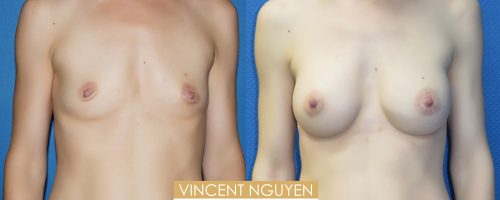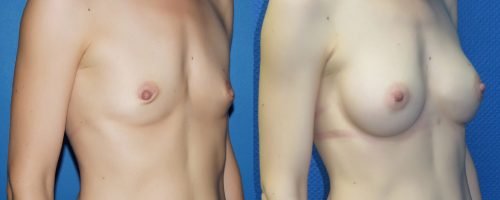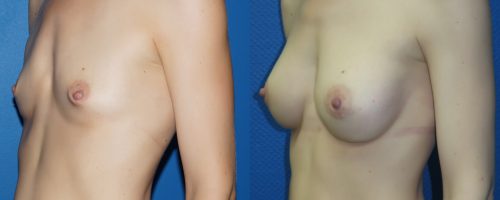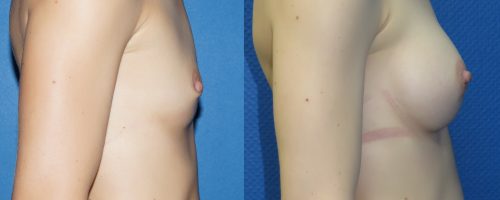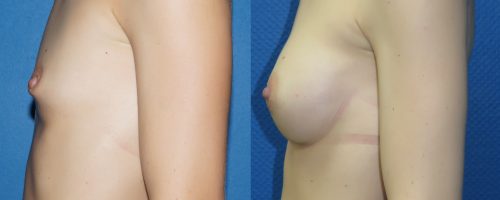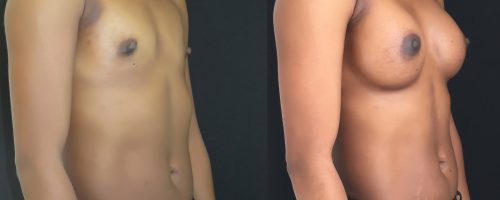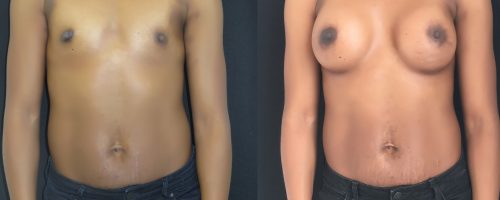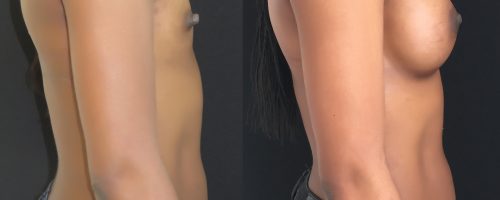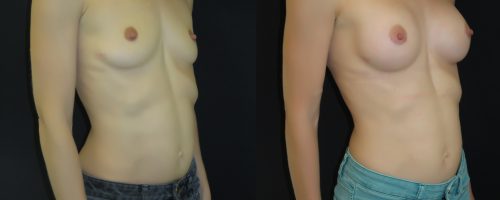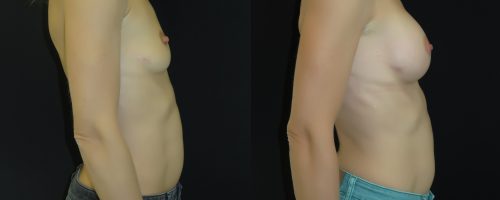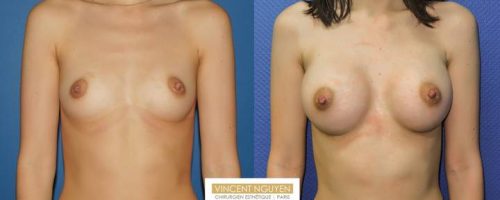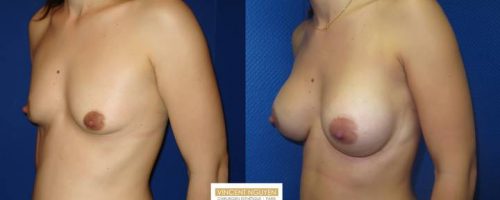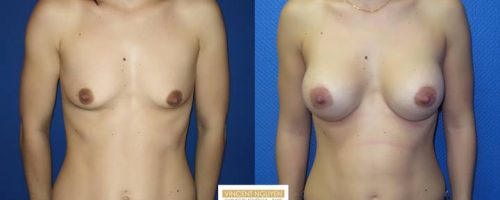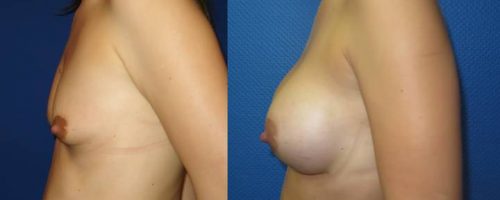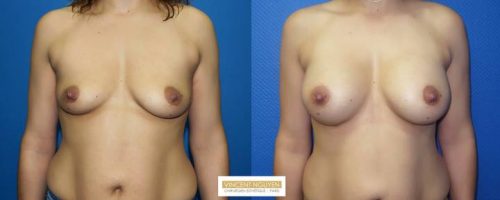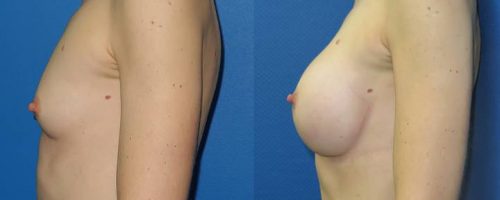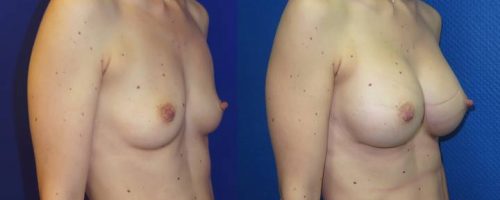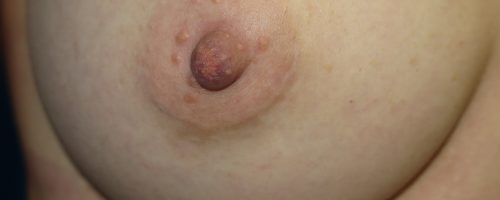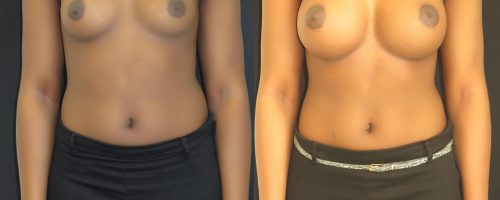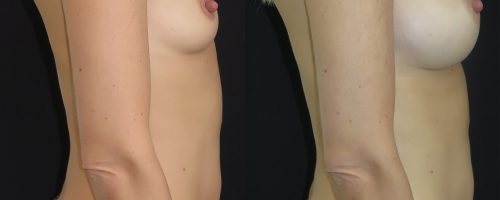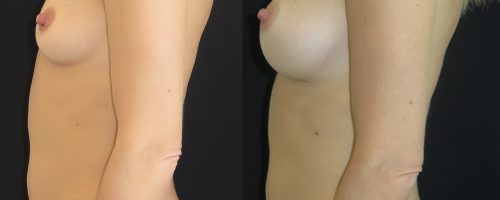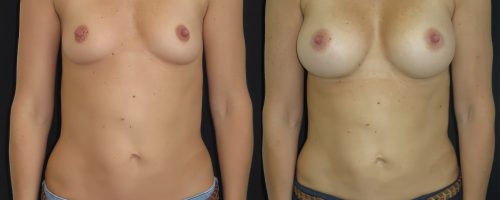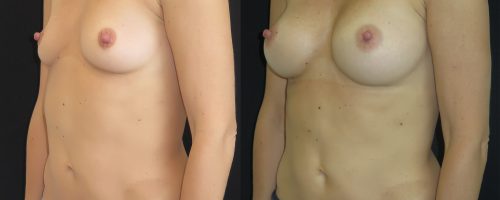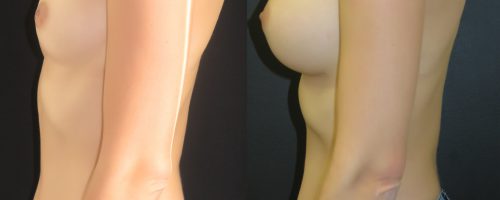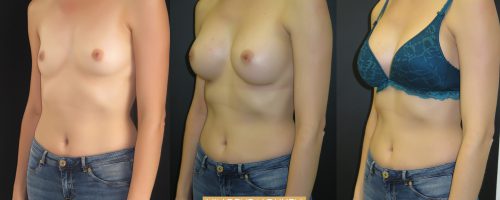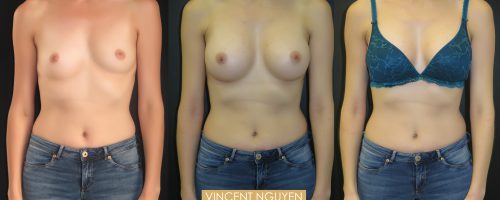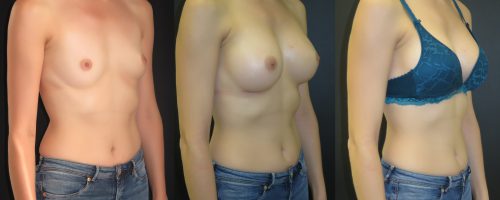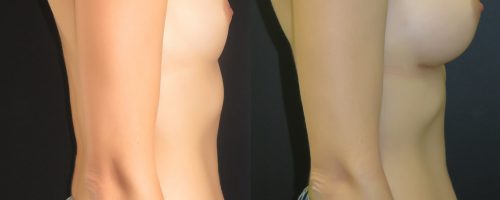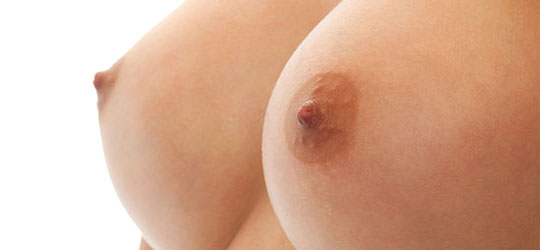Breast augmentation with prosthesis is one of the most popular esthetic surgery procedures in the world. There have been many surgery and implant innovations in the last few years that make the procedure quick and safe, with easy recovery, when performed by a competent board-certified plastic surgeon. The result is natural and reliable due to the wide range of breast implants and surgical techniques.
- Simple and quick surgery.
- Natural outcome due to new surgical techniques (dual plane, hybrid breast augmentation…)
- Wide range of shapes and sizes of breast implants.
- Quick recovery and outpatient procedure possible.
BREAST AUGMENTATION WITH IMPLANTS OVERVIEW
This information sheet is issued by Dr. Vincent Nguyen, board-certified plastic surgeon in Paris, specialized in breast augmentation with implant procedures. He will evaluate your needs, discuss your options and guide you to find the best procedure, implants, implant placements, shape and size to meet your expectations and achieve the best results for you.
It provides all the information about the surgery, scars, recovery, before and after comparison photographs, Social Security coverage and the costs of breast augmentation with prosthesis surgery.
Why get a breast augmentation with implants?
Women with mammary hypoplasia or breast hypotrophy don’t have proper mammary breast tissue. Their breasts are too small and out of proportion to their body.
It may be due to a lack of development of the mammary gland during puberty, loss of breast volume after pregnancy, hormonal fluctuations or weight loss.
Patients with breast hypertrophy may feel so distressed by their physical condition that it affects their femininity. Some feel insecure and suffer from low self-esteem. Others even develop complexes.
Dr Vincent Nguyen can help patients increase the size of their breast, to make them feel more at ease with their body image and more confident.
What are the benefits of breast augmentation with implants?
Breast augmentation with implants allows patients who feel their breasts are not in proportion with their body, to enhance the size of their breasts with a wide variety of sizes and shapes.
The procedure is secure with numerous benefits and little complication risks if performed by a board-certified and competent plastic surgeon.
What are the different types of breast implants?
The various implants differ by their:
- Shape: round, anatomical (teardrop), asymmetrical, custom-made
- Shell: smooth, micro textured, textured, macro textured, with or without polyurethane
- Fillers: saline-filled or silicone gel–filled or hydrogel
- Volume and projection: low-profile, mid-profile or high-profile
- Consistency: cohesive, firm, soft, with double gel
- Brands: Allergan, Mentor, Sebbin, Eurosilicone, Arion…
Current implants have undergone so many improvements recently that breast implants now closely mimic the look and feel of natural attractive breasts in harmony with the patient’s body.
The wide choice of implants allows the plastic surgeon to customize the breast augmentation to the body of the patient, in the best natural way.
All the implants available in France and used by Dr. Vincent Nguyen are EC (European Community) stamped and ANSM (French National Agency for the Safety of Medicines) approved.
Benefits and disadvantages of anatomical implants vs round breast implants:
Anatomical breast implants or teardrop implants, give the appearance of real breasts. As for any other breast implants there is a wide range of sizes, shapes and consistency that can achieve a very natural outcome on many patients.
Its only disadvantage is that there is a risk, even if minimal, of implant rotation in the first three months after the procedure. However, it has become rare with the dual plane technique, textured implants and breast compression wraps.
PRINCIPLES OF BREAST AUGMENTATION WITH IMPLANTS
Where are the incision scars for a breast implant surgery?
The scars are hidden in inconspicuous locations, in natural folds so that they are barely noticeable (see picture):
- periareolar approach: the incision is made around the lower border of the areola.
- Axillary approach: the incision is made through the armpit.
- Inframmary approach: the incision sits in the crease below the breast.
But not every incision location is available for every type of implant.
What are the possible placements of the implants?
Through the incisions, the implants may be placed differently (see picture):
- Subglandular placement: the implant is placed directly behind the mammary gland and in front of the pectoral muscle.
- Subpectoral placement: the implant is lodged beneath the pectoral muscle.
- Dual-plane placement: the implant is lodged partly behind the breast and partly beneath the pectoral muscle.
THE STEPS INVOLVED IN BREAST AUGMENTATION PROCEDURES USING A PROSTHESIS
BEFORE BREAST AUGMENTATION WITH IMPLANTS:
- Two preoperative consultations with a board-certified plastic surgeon will be conducted as well as a consultation with an anesthetist.
- A mammography or/ and an ultrasound will be prescribed.
- Before and after comparison photographs will be taken.
- A post-surgical compression bra, wireless and front opening, will be prescribed.
- Preoperative instructions are as follow:
- Quit smoking at least one month before the surgery and up to 1 month after the surgery to avoid any complication or necrosis risk.
- Discontinue any anti-platelet or blood-thinning medication 15 days before the surgery.
BREAST AUGMENTATION WITH IMPLANTS SURGERY:
- It is performed under general anesthesia.
- The patient is in a sit-up position to create an optimal breast symmetry.
- It lasts about one hour.
- Dr Vincent Nguyen uses the most advanced surgical techniques that avoid the use of drains and performs the surgery himself on both breasts.
The final result is visible 3 months after the surgery but the psychological and physical benefits are immediate.
AFTER BREAST AUGMENTATION WITH IMPLANTS:
- As breast augmentation may be painful, especially if the implant is placed behind the muscle, analgesics will be prescribed to relieve the pain.
- Patients may go home the following day or even the same day.
- Swelling and bruising appear on the breasts the following days.
- No nursing care is required after the surgery.
- You may have a shower the following day but you can’t have a bath before a month after the surgery.
- As the sutures are made with absorbable material, you won’t need to have them removed.
- You will have to wear a contention bra for 6 weeks night and day to avoid bad scarring.
- Avoid sun exposure to the scars for a year at least.
- Most patients may go back to work after 5 days to 2 weeks depending on the nature of their job.
- You may resume physical activities after 6 weeks.
- Follow-up consultations with Dr Vincent Nguyen will be planned (1 week, 1 month, 3 months, 6 months and a year after the surgery).
BREAST AUGMENTATION WITH IMPLANTS: PRICE AND COST
- As breast augmentation with implants is an esthetic procedure, there is no coverage by Social Security or Health Insurance Company.
- The costs may vary depending on the patient, on the type of implants, on incision scars, on other combined procedures, on the location of the surgery, on the length of the procedure and other related expenses. The costs may vary from …. To … (find all the costs on this website).
- Part of this breast surgery may be covered by Social Security or some Health Insurance Companies for these pathologies: bilateral breast agenesis, bilateral breast hypoplasia, malformative syndrome (Poland syndrome or tuberous breast). The pathology must be confirmed by the Social Security Medical Advisor who delivers a prior agreement.
- Make sure to find a board-certified plastic surgeon specialized in breast augmentation who will evaluate your needs, discuss your options and guide you to achieve what is the best option for you.
BREAST AUGMENTATION WITH IMPLANTS FAQs:
What is Dual-plane implant placement technique?
It is a very innovative, very popular technique due to its highly significant benefits.
Dr Vincent Nguyen is a highly skilled specialist of the Dual plane technique.
In the Dual-plane technique, the implant is placed under the pectoral muscle at the upper part of the breast and under the mammary gland at the lower part of the breast.
The purpose of this particular placement of the implant is to give a natural shape to the breast even if the augmentation is significant.
The muscle flattens and conceals the implant in its upper part.
In its lower part, the implant placed under natural breast tissues sits in a more natural position. The outcome is subtle and harmonious.
The Dual-plane technique allows the patient to achieve a natural-looking outcome even with a round implant, thus avoiding rotation issues of anatomical breast implants.
It allows for a pleasant aging process of the breast contrary to a retro muscular technique.
What other procedures may be combined with breast augmentation with implants?
- When the breasts are drooping and look deflated, it may be necessary to combine a breast augmentation with implant with a breast lift (or mastopexy). In that case, you will add the scars that come with a breast lift.
- Hybrid breast augmentation is one of the latest plastic surgery trends. It combines a breast augmentation with implants with a breast lipofilling. The main advantage of this procedure is that adding fat to a breast augmentation with implant allows to conceal the contours of the implant with the patient’s own fat. It softens the edges and gives a more natural outcome.
What are the alternatives to a breast augmentation with implants?
The main alternative is a breast augmentation with lipofilling, or injection of autologous fat (see information sheet). It is a 100% natural procedure, suitable for patients who have enough fat tissue and who don’t want a substantial increase in volume.
Is there a link between breast implants and breast cancer?
So far, there is no connection between breast implants and breast cancer (ductal or lobular carcinoma, in situ or invasive).
What about PIP breast implants?
The scandal about PIP breast implants is due to the fact that the manufacturer fraudulently produced implants with unapproved silicone gel. Food-grade silicone was used instead of medical-grade silicone to lower the price of the prosthesis.
This terrible story has done a lot of damage to the reputation of breast implants. As a result, the European Commission has issued new regulations to provide high levels of safety to restore public confidence in breast implants. Patients with PIP implants may have them removed, the cost being covered by Social Security, as there are still some issues about their impact on patients’ health in case of rupture.
How long do breast implants last?
Although breast implants don’t expire, they are not guaranteed to last a lifetime. It depends on anatomical factors around the prosthesis and on many other factors. Some may last 20 years, others only 3 years, but the average time is 10 years.
What is a periprosthetic scar capsule?
When a foreign body, such as a breast implant, is placed in your body, a thin fibrous capsule naturally forms around the implant as a physiological response to isolate it from your body. Sometimes this capsule can harden: it is called capsular contracture. It may distort the shape of the breast and even cause pain but it looks normal.
There are four grades of capsular contracture known as Baker Grading Scale:
- Grade 1: breast is normally soft and looks normal.
- Grade 2: breast is a little firm.
- Grade 3: breast is firm and may cause discomfort but looks normal.
- Grade 4: breast is hard, painful and looks abnormal.
When the capsular contracture is considered severe, it may require reoperation to remove the scar tissues and the implant but this complication is not very frequent.
How do implants affect pregnancy and breastfeeding?
Breast implants have no effect on pregnancy nor on breastfeeding. Patients may breastfeed their child naturally. There is no risk for the baby, as the levels of silicone are not any higher in women with implants, than without implants.
Do breast implants affect breast sensitivity?
Immediately after surgery patients may experience areola hypersensitivity or hyposensitivity in the lower part of the breast but they typically resolve after a while.
What is a polyurethane prosthesis?
A polyurethane breast prosthesis is an implant coated with polyurethane foam. There are as many shapes as any other implant (round, anatomical and conical) and they have been shown to reduce capsular contracture. There is also less risk of rotation or migration once they are positioned as polyurethane holds it in place (it acts as Velcro). As they are not as common as other implants, they are more expensive.
What is a hydrogel breast implant?
It is a breast implant filled with a biodegradable hydrogel instead of silicone gel. These implants are not very popular due to high inflammatory risk associated with them in case of rupture, as the substance is not (unlike silicone) inert.
Are saline prosthesis a better choice than silicone implants?
There are many advantages to choose saline prosthesis but also many disadvantages.
Advantages:
- in case of rupture there is no silicone leak. But nowadays there is no risk of silicone migration. Both silicone and saline implants have an outer silicone shell.
- Saline implants are inserted empty and then filled, so the incision scar is a little smaller but it is not really significant.
- As saline implants are filled during the procedure, the surgeon may increase the volume for improved breast symmetry. However, nowadays with the pre-operative tests and the wide range of implants the result will be as good as with silicone implants.
Disadvantages:
- Saline implants look and feel less natural than silicone implants since saline has a different feel than fat. Immediately after the procedure the implant is hard but tends to deflate over time. The aspect may vary from over inflated with an artificial outcome (especially for patients with modest breast tissue) to the feel of a water balloon. Rippling may also occur when the implant develops wrinkles. Patients may feel these ripples which can sometimes be seen through the skin. Silicone implants give a more realistic feel and look more like natural breasts.
- If a saline implant ruptures, it deflates like a balloon and the breast loses its volume and its shape. If a silicone implant ruptures, the cohesive gel stays in the implant. It doesn’t migrate and the breast keeps its shape. The rupture might not be noticed.
- Other specific risks may occur with saline implants: fungal infection or crystallization of saline solution. There are no such risks with silicone implants.
- The average lifespan of breast implant is shorter for saline implants (not longer than 10 years) than for silicone implants.
Silicone gel implants are the most popular breast implants among board-certified plastic surgeons due to the numerous benefits as seen above.
Breast implants with soft or firm gel?
There are many different kind of gels so that every patient may find what is best for their body. To achieve the best natural result, it is better to select a cohesive gel implant, firm but soft to the touch.
What is breast augmentation without scars?
It is a breast augmentation without implant but with lipofilling or fat injection (see information sheet). There are advantages but also disadvantages to this procedure.
What is breast augmentation with Macrolane?
The use of Hyaluronic Acid in breast augmentation is totally prohibited in France as it is associated with high complication rates (granuloma and infections) and because it is more difficult to carry out breast cancer screening tests.
Textured or smooth prosthesis?
Anatomical prosthesis must be textured or micro-textured to avoid a rotation risk. Round prosthesis must be smooth or micro-textured to avoid a capsular contracture risk.
May patients be pregnant and breastfeed with breast implants?
Breast implants have no impact on pregnancy and don’t interfere with breastfeeding. As the implants are inserted under the muscle and/or under the glandular tissue, patient are able to breastfeed. Silicone won’t migrate into breast milk as it is a cohesive gel.
When should I change my breast implants?
Breast implants should be changed every 7 to 10 years according to the last studies or when they rupture. (silicone implant may rupture without being noticed).
Should patients with breast implants have frequent check-ups?
After breast augmentation with implants, it is advised to have a medical examination 1 month, 3 months, 6 months and a year after the surgery to make sure that there is no capsular contracture. Then again 3 years later and a clinical surveillance and a radiology follow-up every year after the first 5 years.
What is the best radiology exam after breast augmentation with implants?
The best radiologic exam is breast MRI but mammography and breast ultrasound may also be useful with competent radiologists.
What can be done if patient develops capsular contracture?
The surgeon removes the scar tissue or capsule (capsulectomy) and decides with the patient to place another implant or not as there is still a risk that capsular contracture occurs again.

